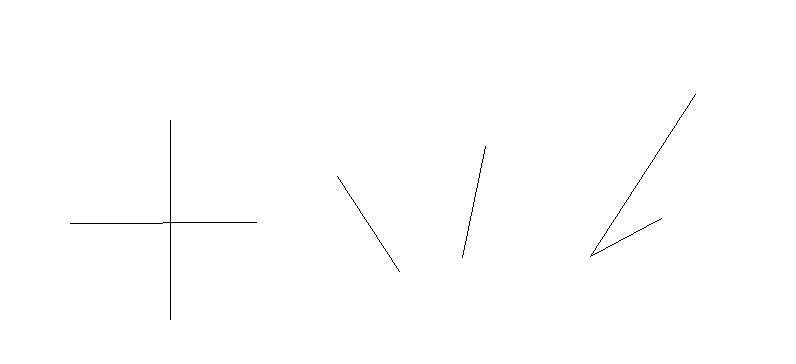标签:return 点积 断线 fabs print put tle log 第一个
下面三种情况比较特殊,特别是第三种

G++怎么交都是WA,同样的代码C++A了
#include <iostream> #include <cstdio> #include <cstring> #include <algorithm> #include <cmath> using namespace std; const double eps = 1e-8; const double PI = acos(-1.0); const double INF = 1e5; int sgn(double x) { if(fabs(x) < eps) return 0; return x < 0 ? -1:1; } struct Point { double x,y; Point() {} Point(double _x,double _y) { x = _x,y = _y; } Point operator -(const Point &b)const { return Point(x - b.x,y - b.y); } //叉积 double operator ^(const Point &b)const { return x*b.y - y*b.x; } //点积 double operator *(const Point &b)const { return x*b.x + y*b.y; } }; struct Line { Point p,q; Line() {}; Line(Point _p,Point _q) { p = _p,q = _q; } //两直线相交求交点 //第一个值为0表示直线重合,为1表示平行,为2表示相交 //只有第一个值为2时,交点才有意义 pair<int,Point> operator &(const Line &b)const { Point res = p; if(sgn((p-q)^(b.p-b.q)) == 0) { if(sgn((p-b.q)^(b.p-b.q)) == 0) return make_pair(0,res);//重合 else return make_pair(1,res);//平行 } double t = ((p-b.p)^(b.p-b.q))/((p-q)^(b.p-b.q)); res.x += (q.x-p.x)*t; res.y += (q.y-p.y)*t; return make_pair(2,res); } }; //*判断线段相交 bool inter(Line l1,Line l2) { return max(l1.p.x,l1.q.x) >= min(l2.p.x,l2.q.x) && max(l2.p.x,l2.q.x) >= min(l1.p.x,l1.q.x) && max(l1.p.y,l1.q.y) >= min(l2.p.y,l2.q.y) && max(l2.p.y,l2.q.y) >= min(l1.p.y,l1.q.y) && sgn((l2.p-l1.q)^(l1.p-l1.q))*sgn((l2.q-l1.q)^(l1.p-l1.q)) <= 0 && sgn((l1.p-l2.q)^(l2.p-l2.q))*sgn((l1.q-l2.q)^(l2.p-l2.q)) <= 0; } Point pot[105],peg; double rad; int main() { // freopen("in.txt","r",stdin); int t; double x1,y1,x2,y2; scanf("%d",&t); while(t--) { scanf("%lf%lf%lf%lf",&x1,&y1,&x2,&y2); Line L1=Line(Point(x1,y1),Point(x2,y2)); scanf("%lf%lf%lf%lf",&x1,&y1,&x2,&y2); Line L2=Line(Point(x1,y1),Point(x2,y2)); if(sgn(L1.p.y - L1.q.y)==0 || sgn(L2.p.y - L2.q.y)==0) { puts("0.00"); continue; } if(!inter(L1,L2)) { puts("0.00"); continue; } if(sgn(L1.p.y - L1.q.y) < 0) swap(L1.p,L1.q); if(sgn(L2.p.y - L2.q.y) < 0) swap(L2.p,L2.q); if(inter(Line(L1.p,Point(L1.p.x,INF)),L2)) { puts("0.00"); continue; } if(inter(Line(L2.p,Point(L2.p.x,INF)),L1)) { puts("0.00"); continue; } pair<int,Point> pr=L1 & L2; Point cp=pr.second; pr=Line(L1.p,Point(INF,L1.p.y)) & L2; double ans=fabs((L1.p-cp)^(pr.second-cp))/2; pr=Line(L2.p,Point(INF,L2.p.y)) & L1; ans=min(ans,fabs((L2.p-cp)^(pr.second-cp))/2); printf("%.2lf\n",ans); } return 0; }
POJ 2826 An Easy Problem? 判断线段相交
标签:return 点积 断线 fabs print put tle log 第一个
原文地址:http://www.cnblogs.com/pach/p/7220927.html